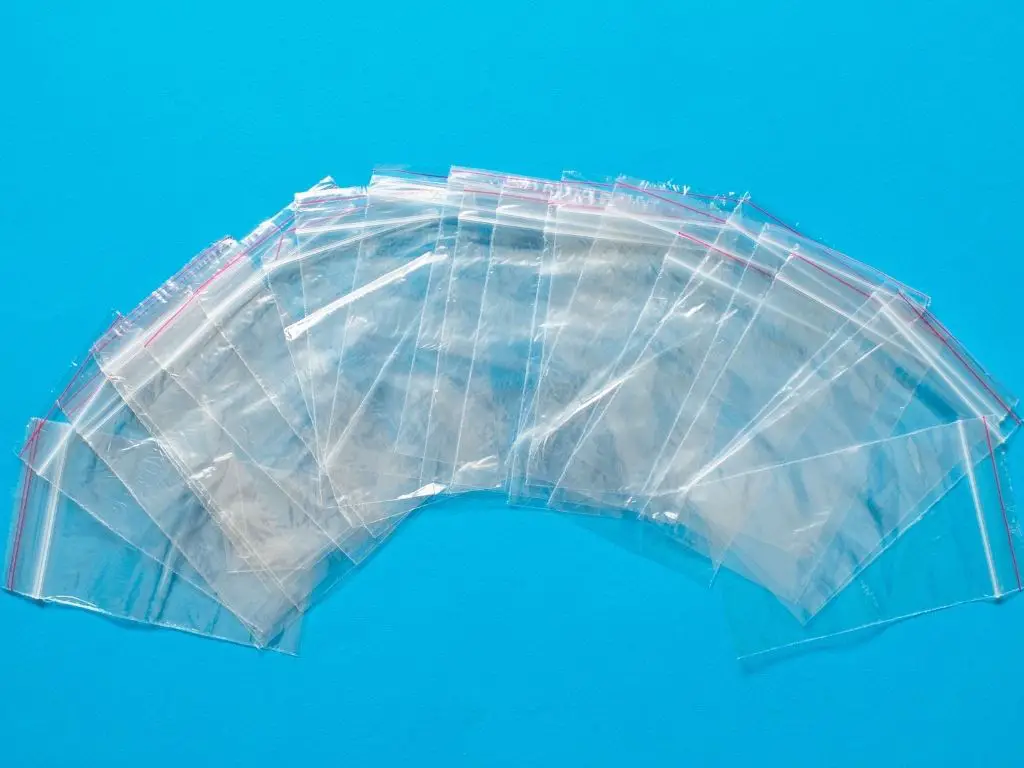Ziplock bags are a ubiquitous household item used for food storage and meal prep. Their convenience and durability make them a staple in many kitchens. However, concerns have been raised over the years regarding the safety of the plastics used to make ziplock bags, specifically polyvinyl chloride (PVC).

Sous Vide Products I Use Every Day
As an Amazon affiliate, I earn from qualifying purchases.
Last update on 2025-03-03 / Affiliate links / Images from Amazon Product Advertising API
What is PVC?
PVC or polyvinyl chloride is a type of plastic commonly used to make food packaging. It is durable, transparent and cost-effective to produce. However, PVC is also controversial due to concerns about its impacts on human health and the environment.
PVC contains hazardous chemicals called phthalates that are added to make the plastic flexible and pliable. Phthalates are endocrine disruptors that can leach out of PVC products into food and drink. Exposure to phthalates has been linked to adverse health effects including asthma, neurodevelopmental issues, and cancer.
PVC production and disposal also creates dioxins, which are highly toxic chemicals that persist in the environment. Dioxins bioaccumulate up the food chain and have been associated with reproductive issues, liver damage and immune system impairment in humans.
Because of these concerns, many consumers want to avoid PVC, especially in food contact items like plastic wrap and ziplock bags. This has led to increased demand for PVC-free and non-toxic plastics.
Do Ziplock Bags Contain PVC?
Many standard ziplock bags are made from PVC. However, not all ziplock bags contain this controversial plastic.
To determine if a ziplock bag is PVC-free, check the recycling symbol and number on the bottom. PVC is marked with a “3” or “V”. Ziplock bags made from other plastics like polyethylene (PE) will be marked with a “4” and are considered safer.
Brands like Ziploc have phased out PVC but many generic, cheaper ziplock bags still contain PVC. Consumers have to carefully read labels and packaging to avoid this plastic.
Are Ziplock Bags Safe for Food Storage?
Whether ziplock bags are safe for storing food depends on the type of plastic they are made from.
- PVC ziplock bags may not be safe for food storage due to concerns over phthalates and plasticizers leaching into food, especially when heated in the microwave. PVC should be avoided for fatty, acidic, or alcoholic foods.
- PE ziplock bags are considered food-safe and do not contain phthalates. PE bags are fine for room temperature storage and freezing. Most are also microwave-safe but check manufacturer guidelines.
- BPA-free ziplock bags do not contain bisphenol A, an endocrine disruptor that has been banned from baby bottles and other food packaging. However, BPA-free bags can still contain PVC or other chemicals of concern.
To reduce risks, do not microwave any plastic bags. Avoid reuse and heating of older, scratched or damaged bags which can increase chemical leaching. And opt for PVC/BPA-free bags when possible.
Alternatives to Ziplock Bags
For those wishing to avoid PVC and single-use plastics entirely, there are many reusable, eco-friendly alternatives to ziplock bags:
1. Silicone Food Storage Bags
- Silicone is considered a non-toxic plastic safe for food contact.
- Reusable silicone bags are durable, flexible and watertight.
- They can be used for freezing, microwaving, and sous vide cooking.
- Easy to clean and sanitize in the dishwasher.
2. Beeswax Wraps
- Beeswax wraps made from cotton and bee’s wax provide an eco-friendly plastic wrap alternative.
- Reusable, biodegradable, and compostable at end of life.
- Creates an airtight seal to store foods without single-use plastic.
- Can be used to cover bowls and wrap bread, cheese, produce, etc.
3. Glass Containers
- Borosilicate glass is entirely non-toxic and inert.
- Glass containers are endlessly reusable and recyclable.
- They do not degrade over time like plastics.
- Glass provides the best food-safe storage, especially for acidic or fatty contents.
4. Stainless Steel Containers
- Stainless steel is durable, non-toxic and impermeable.
- Metal containers are oven, freezer and dishwasher safe.
- Stainless steel is indefinitely reusable and ultimately recyclable.
- Useful for storing and transporting meals and leftovers.
5. Cloth Bags
- Natural fiber cloth bags can replace ziplock bags for pantry items like flour, rice, etc.
- Cotton, hemp, and linen bags are washable, reusable and biodegradable.
- Muslin or mesh drawstring bags good for produce and snacks.
- Cheap and readily available alternative to single-use plastic baggies.
Conclusion: Choosing Safe and Eco-Friendly Food Storage Options
Plastic ziplock bags offer convenience for food storage. But concerns over chemicals like PVC and BPA have many consumers seeking out safer, plastic-free options that are kinder to human health and the environment.
Carefully read labels and avoid plastics marked with 3 or V to steer clear of PVC. Polyethylene bags are considered food-safe but reusable silicone, glass, stainless steel or cloth bags are the most chemical-free and sustainable ziplock bag alternatives.
Making informed choices about food storage containers allows you to reduce plastic waste and chemical exposure while keeping your food fresh. With some clever reusable solutions, it’s easy to avoid questionable plastics like PVC and have peace of mind that your foods are safe from harmful chemicals leaching into them.


![IMPRESA [10 Pack] Sous Vide Magnet Weights for Keeping Bags Submerged – Sous Vide Accessories to Stop Floating Bags & Undercooking – Weighted Magnets for Containers](https://m.media-amazon.com/images/I/41zHpl8G2lL._SL160_.jpg)

